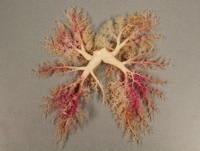Morphology
The use of silicone moulds in documenting morphological characteristics from wildlife
The gathering of morphological data from wildlife is important for the documentation of evolutionary processes. Because high quality soft tissue specimens are more difficult to gather and store than for example skeletal specimens, we have used silicone casts to collect morphological data from free-ranging mammals. Because of the hydrophilic properties of the compound used in our studies, extensive drying of the specimens in laboratory conditions is not necessary before casting, and the silicone material can also be hardened in relatively cold temperatures (field conditions). The easy casting process makes it possible to prepare multiple specimens in a relatively short time for comparative anatomical studies. These moulds have been useful in our studies on pulmonary anatomy of lynx and on the gastromorphology of Laonastes rodents. Currently we are working on various aspects of Saimaa seal anatomy.
The use of silicone moulds in veterinary anatomy
With the use of laser scanning, we have also used silicone moulds to produce digital 3D models on cow teat morphology. Computer analysis of the external and internal teat morphology showed that the basic morphology of individual teats were similar within each cow, but differed among the cow individuals.
The silicone moulds and digital images have also proven to be useful in teaching of wildlife and veterinary anatomy.

Digital elevation models of the external surface surrounding the teat orifice. The headline figures show determination of surface orientation of teats by measuring the orientation patch counts which are used to produce the 3D models


